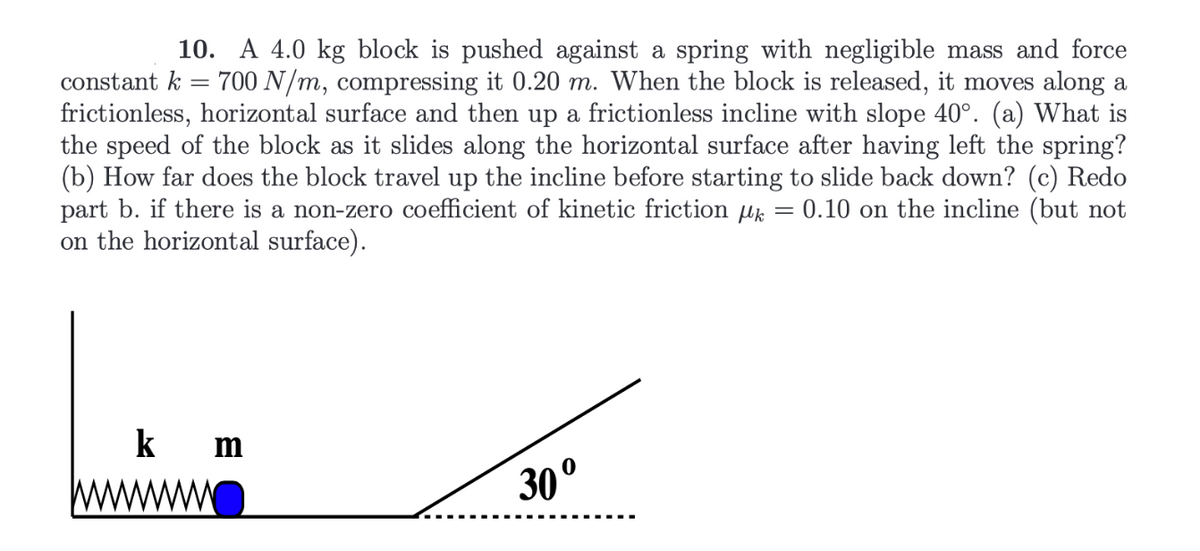10. A 4.0 kg block is pushed against a spring with negligible mass and force constant k = 700 N/m, compressing it 0.20 m. When the block is released, it moves along a frictionless, horizontal surface and then up a frictionless incline with slope 40°. (a) What is the speed of the block as it slides along the horizontal surface after having left the spring? (b) How far does the block travel up the incline before starting to slide back down? (c) Redo part b. if there is a non-zero coefficient of kinetic friction k = 0.10 on the incline (but not on the horizontal surface). km 30°
10. A 4.0 kg block is pushed against a spring with negligible mass and force constant k = 700 N/m, compressing it 0.20 m. When the block is released, it moves along a frictionless, horizontal surface and then up a frictionless incline with slope 40°. (a) What is the speed of the block as it slides along the horizontal surface after having left the spring? (b) How far does the block travel up the incline before starting to slide back down? (c) Redo part b. if there is a non-zero coefficient of kinetic friction k = 0.10 on the incline (but not on the horizontal surface). km 30°
Principles of Physics: A Calculus-Based Text
5th Edition
ISBN:9781133104261
Author:Raymond A. Serway, John W. Jewett
Publisher:Raymond A. Serway, John W. Jewett
Chapter7: Conservation Of Energy
Section: Chapter Questions
Problem 79P: A block of mass 0.500 kg is pushed against a horizontal spring of negligible mass until the spring...
Related questions
Question

Transcribed Image Text:10. A 4.0 kg block is pushed against a spring with negligible mass and force
constant k = 700 N/m, compressing it 0.20 m. When the block is released, it moves along a
frictionless, horizontal surface and then up a frictionless incline with slope 40°. (a) What is
the speed of the block as it slides along the horizontal surface after having left the spring?
(b) How far does the block travel up the incline before starting to slide back down? (c) Redo
part b. if there is a non-zero coefficient of kinetic friction k = 0.10 on the incline (but not
on the horizontal surface).
k
m
30º
Expert Solution
This question has been solved!
Explore an expertly crafted, step-by-step solution for a thorough understanding of key concepts.
This is a popular solution!
Trending now
This is a popular solution!
Step by step
Solved in 3 steps with 3 images

Knowledge Booster
Learn more about
Need a deep-dive on the concept behind this application? Look no further. Learn more about this topic, physics and related others by exploring similar questions and additional content below.Recommended textbooks for you

Principles of Physics: A Calculus-Based Text
Physics
ISBN:
9781133104261
Author:
Raymond A. Serway, John W. Jewett
Publisher:
Cengage Learning

University Physics Volume 1
Physics
ISBN:
9781938168277
Author:
William Moebs, Samuel J. Ling, Jeff Sanny
Publisher:
OpenStax - Rice University

Physics for Scientists and Engineers: Foundations…
Physics
ISBN:
9781133939146
Author:
Katz, Debora M.
Publisher:
Cengage Learning

Principles of Physics: A Calculus-Based Text
Physics
ISBN:
9781133104261
Author:
Raymond A. Serway, John W. Jewett
Publisher:
Cengage Learning

University Physics Volume 1
Physics
ISBN:
9781938168277
Author:
William Moebs, Samuel J. Ling, Jeff Sanny
Publisher:
OpenStax - Rice University

Physics for Scientists and Engineers: Foundations…
Physics
ISBN:
9781133939146
Author:
Katz, Debora M.
Publisher:
Cengage Learning

College Physics
Physics
ISBN:
9781285737027
Author:
Raymond A. Serway, Chris Vuille
Publisher:
Cengage Learning

Physics for Scientists and Engineers, Technology …
Physics
ISBN:
9781305116399
Author:
Raymond A. Serway, John W. Jewett
Publisher:
Cengage Learning

Physics for Scientists and Engineers
Physics
ISBN:
9781337553278
Author:
Raymond A. Serway, John W. Jewett
Publisher:
Cengage Learning